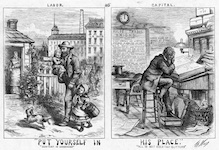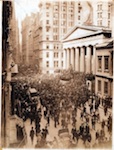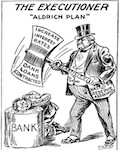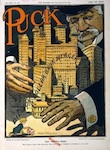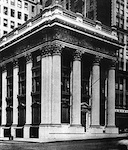|
 |

Primary Sources
Baker, John Calhoun. Executive Salaries and Bonus Plans. New York: McGraw-Hill Book Company, Inc., 1938.
Baker, Ray Stannard. “What The U.S. Steel Corporation Really Is, And How It Works.” McClure’s Magazine, November 1901, 4.
Beadle, J. H. “The Eccentric Rich.” The North American, July 6, 1892, 2.
Cotter, Arundel. The Authentic History of the United States Steel Corporation. New York: Moody Magazine and Book Company, 1916.
Cotter, Arundel. The Gary I Knew. Boston: The Stratford Company, 1928.
Cotter, Arundel. The Story of Bethlehem Steel. New York: Moody Magazine and Book Company, 1916.
Cotter, Arundel. United States Steel: A Corporation With a Soul. Garden City, NY: Doubleday, Page & Company, 1921.
Dow, Jones & Co. A Decade In United States Steel. New York: The Wall Street Journal, 1911.
Editorial. “Industrial and Railroad Consolidation.” Harper’s Weekly, May 4, 1901, 450.
Editorial. “An Eastern paper tells us that J. Pierpont Morgan is a great lover of dogs.” Salt Lake Semi-Weekly Tribune, August 29, 1899, page 4.
Ferguson, Garland S., Jr. “Report of the Federal Trade Commission on Compensation of Officers and Directors of Certain Corporations.” Federal Trade Commission. Washington, DC: February 26, 1934.
General Motors, “Twenty-Sixth Annual Report of General Motors Corporation,” December 31, 1934.
Grosscup, Peter S. “The Rebirth of the Corporation.” The American Magazine, June 1906, 188.
Johnson, Owen. The Sixty-First Second. New York: The McClure Publications, Inc., 1912.
Larson, Henrietta M. Guide to Business History: Materials for the Study of American Business History and Suggestions for their Use. Vol. 12. Harvard Studies in Business History. Cambridge: Harvard University Press, 1948.
Lindbergh, Charles A. Banking and Currency and the Money Trust. Washington, D.C.: National Capital Press, Inc., 1913.
Martin, E. S. “This Busy World.” Harper’s Weekly, March 23, 1901, 319.
Martin, E.S. “This Busy World.” Harper’s Weekly, June 22, 1901, 636.
Mumford, John Kimberly. “This Land of Opportunity: ‘The Watchword of the Hour – Honest Business and Fair Play.’” Harper’s Weekly, June 13, 1908, 20-23.
Noyes, Alexander D. “Money Trust.” The Lamont Papers: The Money Trust Investigation, Box 210, Folder 17.
Senate Resolution 75, 73rd Congress, 1st Session. (1933-34), 77 Cong. Rec. 4474, 4475 (1933).
Tarbell, Ida. “The Hunt for The Money Trust.” The American Magazine, May 1913, 7. The Lamont Papers: The Money Trust Investigation, Box 210, Folder 20.
Taussig, F. W. and W. S. Barker. “American Corporations and Their Executives: A Statistical Inquiry.” The Quarterly Journal of Economics 40, no. 1 (Nov. 1925): 1-51.
Washington, George Thomas. Corporate Executives’ Compensation: Legal and Business Aspects of Salary and Bonus Plans, Stock Options, Pensions, Indemnity Agreement, and Related Matters. New York: The Ronald Press Company, 1942.
Williams, John Skelton. “N.Y. Reserve Bank Salaries Attacked.” New York Times, October 21, 1921.
“Analysis of Money Trust.” New York Times, March 1, 1913.
“Bank Situation Clarified, But a Trust Company in Trouble.” The Wall Street Journal, October 23, 1907, 1.
“Bankers Confer With Mr. Morgan: Long Discussion in His Library Not Ended Until 4 o’Clock this Morning.” New York Times, November 4, 1907.
“Bankers’ Support Clears Situation: Relief of Trust Companies Quickly Reflected in Financial District.” New York Times, November 7, 1907.
“Big Salaries Bring Demand for Curbs.” The New York Times, March 5, 1934.
“C. T. Barney Dies, A Suicide.” The New York Times, November 15, 1907, 1.
“Charles T. Barney A Suicide.” The Wall Street Journal, November 15, 1907, 7.
“Clearing House Has Banking Situation Here Well At Hand.” The Wall Street Journal, October 22, 1907, 1.
“Comments on Miss Tarbell’s Article.” Lamont Papers: Money Trust Investigation, Box 210, Folder 20.
“Commerce Commission goes into Executives’ Salaries.” The Wall Street Journal, December 23, 1922, 12.
“Denies $100,000 Salary.” New York Times, December 25, 1921.
“Dr. Woodrow Wilson Defines Material Issues; Scathing Arraignment of Political and Industrial Conditions Which have Made Possible the Recent Panic in Financial Circles. Radical Reform in Our National Politics Suggested Through the Appointment of a Common Council Selected from College Men.” New York Times, November 24, 1907.
“Fads of Rich Bachelors.” The Milwaukee Journal, May 14, 1892, 12.
“Features of the Market.” The Wall Street Journal, October 22, 1907, 4.
“Five Men in Control $368,000,000; Here: Morgan Influence Shown.” New York Times, December 11, 1912.
“Getting Rich.” The Penny Press, October 3, 1896, 6.
“High Salaries in Hard Times.” New York Times, March 11, 1934.
“Inquiry into High Salaries Pressed by the Government.” New York Times, October 29, 1933.
“J.P. Morgan’s Influence.” Boston Daily Advertiser, September 28, 1899, pg. 4.
“J. Pierpont Morgan – He Is a Power in American Financial Affairs.” The Milwaukee Journal, July 10, 1895, pg. 8.
“John Pierpont Morgan in Human Form: Career of the Man Depicted as Financial Colossus and the Business Genius Has Organized.” New York Times, November 10, 1907.
“Knickerbocker Depositors in Row: Rival Factions Accuse Each Other at Carnegie Lyceum Mass Meeting.” The New York Times, November 5, 2009, 2.
“Knickerbocker Trust Co. Guy Morrison Walker, a Large Depositor, Proposes Plan for Company’s Reorganization.” The Wall Street Journal, November 5, 1907, 2.
“Knickerbocker Will Be Aided.” The New York Times, October 22, 1907, 1.
“Knickerbocker Will Not Open.” The New York Times, October 23, 1907, 1.
“Lammot du Pont Defends Scale of Salaries Of General Motors Executives; Is But Half Average of 20 Other Firms on Basis of Net.” Wall Street Journal, April 27, 1938.
“Largest Salary Earned in New York.” The Milwaukee Journal, June 13, 1898, pg. 4.
“Letter from O.W.M. Sprague, The Graduate School of Business Administration, The Office of the Dean Harvard University, Cambridge, MA”, March 20, 1913, The Lamont Papers: The Money Trust Investigation, Box 210, Folder 20.
“Letter to Lamont from The American Magazine”, March 28, 1913, The Lamont Papers: Money Trust Investigation, Box 210, Folder 20.
“London Discussing Morgan’s Opinions.” New York Times, December 22, 1912.
“Lowering High Salaries.” New York Times, July 15, 1933.
“A Man Whose Salary is $60,000 A Year.” The Milwaukee Journal, October 17, 1898, col e.
“Money and Property.” Semi-Weekly Tribune, December 23, 1898, pg. 4.
“Money Trust Investigation of Financial and Monetary Conditions in the United States” under House Resolutions No. 429 and 504. Part 15. December 19, 1912, 1084.
“State Needs to Revise Methods.” New York Times, June 5, 1932
“This Busy World.” Harper’s Weekly, January 25, 1902, 122.
“Topics in Wall Street.” The New York Times, October 22, 1907, 13.
‘Untitled’, 1913. The Lamont Papers: Money Trust Investigation, Box 210, Folder 16.
Secondary Sources
Anderson, Sarah, John Cavanagh, Chuck Collins, Sam Pizzigati, and Mike Lapham. Executive Excess 2008: How Taxpayers Subsidize Runaway Pay, 15th Annual CEO Compensation Survey. Washington, DC: Institute for Policy Studies and United for a Fair Economy, 2008.
https://www.ips-dc.org/reports/executive_excess_2008_how_average_taxpayers_subsidize_runaway_pay.
Berger, Meyer. The Story of The New York Times, 1851-1951. New York: Simon and Schuster, 1951.
Bruner, Robert F. and Sean D. Carr. The Panic of 1907: Lessons Learned from the Market's Perfect Storm. New Jersey: John Wiley & Sons, 2007.
De Long, J. Bradford. J.P. Morgan and His Money Trust. Harvard University, 1991.
Dealy, Francis. The Power and the Money. New York: Birch Lane Press, 1993.
Duncan-Clark, Samuel John. The Progressive Movement: Its Principles and Its Programmes. Boston: Small, Maynard & Company, 1913.
Faulkner, Harold. U. The Decline of Laissez Faire, 1897-1917. New York: Holt, Reinhart and Winston, 1951.
Frydman, Carola. “Learning from the Past: Trends in Executive Compensation over the 20th Century.” CESifo Economic Studies 55, no. 3-4 (2009): 458-481.Salisbury, Harrison. Without Fear or Favor. New York: Times Books, 1980.
Gandel, Stephen. “Wall Street, Meet Ken Feinberg, the Pay Czar.” Time Magazine, November 2, 2009. https://www.time.com/time/business/article/0,8599,1933078,00.html?iid=sphere-inline-sidebar.
Neilson, Winthrop and Frances. What’s News—Dow Jones. Radnor, Pa.: Chilton Book Company, 1973.
Pizzigati, Sam. “Quotes.” Inequality.org, https://www.demos.org/inequality/quotes.cfm.
Rosenberg, Jerry. Inside The Wall Street Journal. New York: Macmillan Publishing Co., 1982.
Salisbury, Harrison. Without Fear or Favor. New York: Times Books, 1980.
Scharff, Edward. Worldly Power: The Making of The Wall Street Journal. New York: Beaufort Books Publishers, 1986.
Story, Louise. “Executives Kept Wealth as Firms Failed, Study Says” New York Times, November 23, 2009, section B3.
Talese, Gay. The Kingdom and the Power. 2nd ed. New York: The World Publishing Company, 1969.
Tucker, Abigail. "The Financial Panic of 1907: Running from History." The Smithsonian Institution. https://www.smithsonianmag.com/history-archaeology/1907_Panic.html?c=y&page=2#ixzz0hN7czKtG
(accessed March 6, 2010).
|
